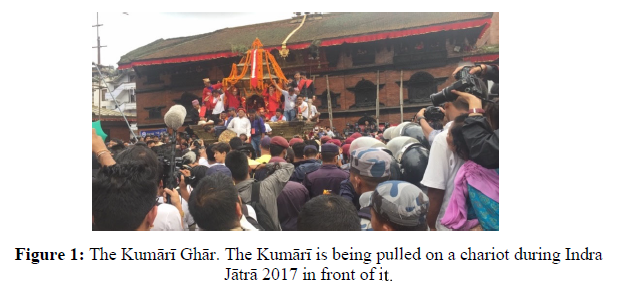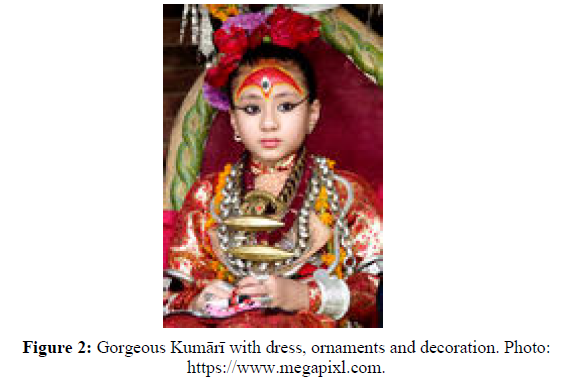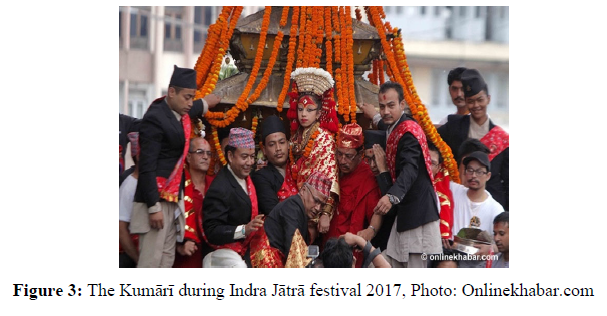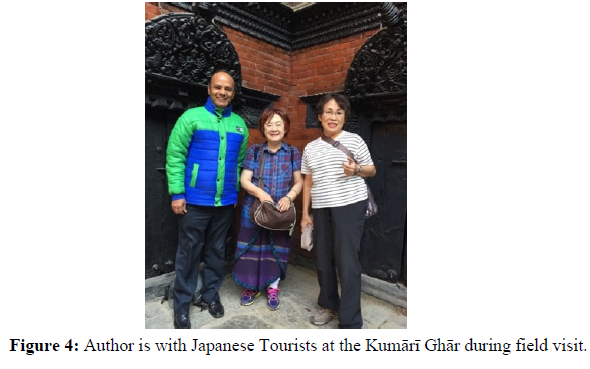Research Article
GORGEOUS KUMĀRĪ–THE LIVING GODDESSES IN NEPAL
912
Views & Citations10
Likes & Shares
As the spirit of the goddess of power, Kumārī- the living goddess is believed to be embodied in a long succession of Nepalese virgin girls, has been worshiped for centuries. The Kumārī is a prepubescent girl who is hailed as manifestations of divine and spiritual energy, the living incarnation of the Hindu goddess of power; a manifestation of Vajradevi or Tara for Buddhist. Kumārī is the girl who has never menstruated. Hindu and Buddhist devotees bow their forehead on the toes of the Kumārī with high level of respect aspiring to fulfil their wishes. The Kumārī is commonly called “Mother Deity or Kumārī ma and believed that she can transmit power or śakti directly into the bodies of devotees who come to have her audience (darśana). The Kumārī culture is one of the Nepali’s identity, historical and cultural heritage. Despite new political development in Nepal, the Kumārī culture, the country’s oldest tradition should be preserved. Knowing, visiting Kumārī- the living goddess could be an attraction to the rest of the world.
Keywords: Manifestations, power, virgin, maṇḍala, darśana, tikā, Jātrā, culture.
BACKGROUND
Nepal, the Himalayan country is situated between China and India steeped in several unique cultures, legends and myths. A beautiful, awe-inspiring land, Nepal is the birthplace of Buddha, the country with the Mount Everest and home to the Kumārī: the living goddesses. The unique and diverse Nepalese culture has been the attraction for rest of the world. It has been blending and carrying the history of thousands of years (Ghimire, 2017). Kumārī- the living goddess, as the spirit of the Tālejū goddess believed to be embodied in a long succession of Nepali girls, has been worshiped for centuries. Hindu and Buddhist devotees bow their forehead on the toes of the living goddesses Kumārī with a high level of respect and desire to fulfil their wishes. We can see hundreds of foreigners who believe in other religious faith waiting her for a grace from a window at Kumārī Ghār[1] (Kumārī House) every day. Definitely, the existence of the Kumārī- living goddess in 21st century world would be a curiosity to observe, meet, see, know and read about her for the people around the globe (Ghimire, 2018).(Figure 1).

The Kumārī is a prepubescent girl who is hailed as manifestations of divine and spiritual energy, the living incarnation of the Hindu goddess of power; for Buddhist devotees, the Kumārī is a manifestation of Vajradevi or Tara. Kumārī is the girl who has never menstruated. Hindu and Buddhist devotees bow their forehead on the toes of the Kumārī with high level of respect aspiring to fulfil their wishes. The Kumārī is commonly called “Mother Deity or Kumārī ma and believed that she can transmit power or śakti directly into the bodies of devotees who come to have her audience (darśana). The Kumārī culture is Nepali’s identity, historical and cultural heritage. The Kumārī culture has not been well-known to the rest of the world adequately. Despite new political development in Nepal, the Kumārī culture, the country’s oldest tradition should be preserved.
THE KUMĀRĪ DIVINE SELVES IN NEPAL
The word Kumārī is derived from the Sanskrit word Kaumarya, which means princess. Literally, it means “virgin” girl. The Kumārī or Kumārī Devi comes from the Hindu faith, however most of the "traditional" Kumārī in Kathmandu are from Newar[1] community. Newar people believe on both Hindu and Buddhist religious faith. Kumārī -Pujā, or 'virgin worship', is a feature of Hinduism of the greatest antiquity dating back at least to the late Vedic period.
Amongst the Newars of Kathmandu valley, the influence of Tantricism on both Hinduism and Buddhism has ensured the importance both of sexuality and the worship of Sakti. In addition to the popularity of such non-Tantric female deities as Saraswati, Laxmi and Parvati, the Newars devote a great deal of their ritual activity to the worship of the Devi in one of her many dangerous, mature and bloodlusting forms (Kali, Durgā, Ajima, Bhairavi, Tālejū, etc.). But the most notable and perhaps unique feature of their religion is the prominence given to the worship of Kumārī, the living virgin goddess (Allen, 1975). (Lidke,2010). writes the identification of the Kumārī with the Great Goddess, Mahā Devī, reveals a key facet of her identity and function as a living divinity: she is the embodiment of a power (śakti) that protects the nation against any and all enemies of state. Though the Kumārī is Buddhist by birth, however, the Tālejū is a very important Hindu Goddess. This unique tradition is a perfect example of the intertwining and religious harmony in Nepal that has long been known for.
The cult of Kumārī has been central to legitimating Hindu[2] kings: different mythological accounts relate the origin of Kumārī as a form taken by Tālejū. During the Malla[3] period (fourteenth to eighteenth century), the three kingdoms of Kathmandu, Lalitpur, and Bhaktapur each had its own royal Kumārī, near the king’s palace. With the unification of Nepal, the Kumārī of Kathmandu became the sole royal - and now national - Kumārī. What follows concerns mainly this national Kumārī, whose ritual life is more strictly regulated, although many of the rules apply, with some variations, to the Kumārīs of Lalitpur and Bhaktapur (Letizia, 2013).
SELECTION OF THE KUMĀRĪ
When the Kumārī passes the prepubescent period, the current Kumārī[4] is no longer eligible to be a vessel for the goddess the search begins to find an appropriate successor. The Kumārī is always chosen from the pure Shakya clan for at least three generations of Kathmandu’s Newar community. Young girls must have the 32 lachchins (perfections and qualities) of the goddess in order to be the Kumārī (Ghimire, 2018).
The list of most important requirements/ perfections are as follows:
Must have perfect health without any history of serious illness
Unblemished skin
Black straight hair curled towards the right side
Gorgeous expressive/dark eyes
Sonorous crystal clear voice
Long slender arms
Delicate and soft hands and feet
No bad body smells
Must not have shed any blood
Virgin with an unblemished body
Body of the Banyan tree
Eyebrows like the cow
White teeth without any gaps
Mona Lisa like smile
Thighs like those of a deer
Neck like a conch-shell
Tongue–small and moist
Twenty unbroken teeth should be present
Sexual organs small and well-recessed
The most important requirement is that the girl has never menstruated. There is a belief that when a Kumārī has her first menstruation, she loses her divine power and is returned back to life as an ordinary girl. If the girl starts menstruating while serving as Kumārī, it is considered inauspicious. To ensure the girl’s compatibility with the King of Nepal, her horoscope was to be compared and must match with his, as the Kumārī has an important role in relation to the King, including the traditional power to confirm the King’s rule in the past (Bhattarai & Shrestha, 2010). Now time and situation has been changed because of this, some ritual aspects have necessarily changed, as the connection that linked the Kumārī and the king has been severed.
During the eighth day of Dashain[5], called Kalratri (black night), selection process of the Kumārī begins. The Kumārī (3-year girl) is left in a room with 108 decapitated buffalos and goats laid out in a sea of blood with men wearing horrid masks dancing among them to test the fearlessness of the girl. If the child gets scared and cries, she will be disqualified and the next girl has to go though the process until they find a girl who can smile in that surrounding and enjoy the dance of the masks men. The young girl is taken into the Tālejū temple's courtyard where the severed heads of the animals are illuminated by candles and masked men dance about. The child must show no fear during any of this. Finally, the girl must spend a night with slaughtered heads of the animals and again show no fear. If she passes these tests the girl is taken for ritual cleansing of her past life. Adorned with the Kumārī clothes and taken to her new house (the Kumārī House). The above are the strict and official rules. However, many of the Kumārī do get to see their families and indeed some of the the family members live with them.
TRANSFORMING VIRGIN GIRL INTO DIVINE KUMĀRĪ
A small virgin girl (2-3) years has to undergo with several sacred activities and participate in various rituals to transform her into the divine Kumārī who can embody such awesome power and be divinity capable of destroying all enemies. One must take into account that the ritual ideology and practice under girds the Kumārī institution. (Lidke, 2010) illustrates transforming of a virgin girls into divine Kumārī’s stem from Tantra, a system of ritual practice and related ideologies that date back to the 4th century. The Tantric tradition—which cuts across the divide between ‘Hindu’ and ‘Buddhist’—assumes that all of existence is an unfolding of a singular conscious energy or śhakti that manifests itself according to a precise geometrical and acoustic pattern termed maṇḍala (territory). They believe that the universe itself is the grandest of maṇḍalas, being the cosmic emanation of śhakti. Girls designated to serve as the Kumārīs are selected because their young, virginal bodies are deemed qualified to serve the nation as vessels for this harnessing of divine power. Through ritual they are temporarily transformed into that cosmic power that is depicted mythologically as Durgā/Tālejū and icono-graphically as that maṇḍala structure whose perfect interwoven forms are the power-patterns that protect the region—at the cosmic, bodily, and state levels—from all enemies. Once the Kumārī is chosen, she must be ritually purified each day so that she can be an unblemished vessel for Tālejū. The heart of the ritual is the placement of the Kumārī on a ritual seat shaped in the form of a maṇḍala while a Tantric priests (both Hindus and Buddhists) worships her with special body postures (mudrās) and liturgical formulae (mantras) that empower her body to be a living manifestation of what the Paddhatis call the Goddess of Universal Form (viśvarūpa-devī) [6]. By the completion of each daily ritual, it understood that the power of the supreme goddess (parādevī) fully resides in the human form of the Royal Kumārī and that therefore she deserves the official title of Tālejū, identifying her as the king’s own sovereign deity (Lidke, 2010). However, time and political situation of Nepal has been changed, the position of king is taken by the president.
LIFE OF KUMĀRĪ
Once new virgin girl is appointed and transformed to the Kumārī, she has to be separated from her parents and family members, and live in the Kumārī Ghār near the ancient palace of the Malla kings in Basantapur, Kathmandu. Throughout her span as the goddess, the Kumārī has to live in isolation from her family. Even when her actual family members visit her, she is treated with respect and a kind of distance because she is no ordinary girl, she is the goddess. A ‘chitaidar’ (woman caretaker of the Kumārī) is assigned to look after the everyday needs and general upbringing of the goddess. Newars and most of the Nepalese, Buddhists and Hindus alike, come to worship her regularly in her house. They also pay respect on the occasion of religious celebrations, when she travels outside her palace on a chariot. Kumārī comes out from her temple (Kumārī Ghār) only for fifteen days in a year when there is special festivals. Rest of the days, she remains inside the Kumārī Ghār.
Largely unknown to the outside world, Nepal's centuries-old institution of the child deity, the Kumārī-the living goddess, is deeply embedded in the culture of Kathmandu Valley. Many politicians, former royal members, government officers, businessman and general public visit the Kumārī Ghār seeking a blessing from the Kumārī for their duties, progress and prosperity on a regular basis. The Kumārī gives a read mark (tikā) to the visitors but she never talks with general visitors. It is believed that a look from the Kumārī and her activities towards a visitor will tell one's future wealth, health and status.
DRESS ORNAMENTS AND DECORATION
The Kumārī is considered as the perfect gorgeousness girl and especially in the Newar community, a girl’s beauty is often compared to that of the Kumārī. The clothing, ornaments and decoration of the Kumārī has been always fascinated to westerners and even Nepalese people. Not only during festivals and other formal occasions, the Kumārī is always dressed in red, because red is considered the color of gods and power among Hindus in Nepal. The Kumārī wears a bright red jama (cloak) down to her feet, a red chaubandi cholo (Nepalese style traditional shirt), and a red pagari (turban) of a pure and special fabrics. She wears ornaments not only around her neck but also on her hands and feet; her hair is gathered in a topknot and decorated with sweet smelling flowers. She bears a third eye (called ‘tri-netra’) painted on her forehead. The third eye is considered as a metaphorical eye, which is believed to destroy all the evil in the world. The Kumārī’s red tikā, which is placed on her forehead (above the third eye) artistically during festivals, is called bhrigu. It represents the cosmic energy of the earth. This brightest and most glowing tikā is a sign of wealth, prosperity and a bright future for the nation. The special tikā is prepared by mixing vermilion powder, rock crystal powder, a kind of sweet scented natural powder called ‘kumkum’ and sesame seed oil (Figure 2).

The Kumārī wears garlands of diamonds and gold coins, and two necklaces of special symbolic significance. One is a golden chain made in the shape of the serpent god called ‘Vāsuki Naga[1]’ on her neck, hanging down to her belly. This ornament has multiple meanings. Firstly, it is considered a symbol of the guardian of the national treasury because Vāsuki Naga was reincarnated as lord Kuber (guardian god of wealth). Another ornament the living goddess wears is a four-inch-long golden tā-yo:, which, has a cylindrical body with a number of edges and a conical shape at both ends. This is sheltered under the umbrella of an eight-headed miniature golden Naga, which symbolizes the eight mother goddesses. The Kumārī wears it around her neck (it extends down to her chest) to indicate her authority with the eight mother goddesses. She also wares beruwa aunthi (gold rings) on fingers, bala (bracelets) and chura (colourful bracelets) on arms.
LIFE AFTER RETIREMENT
A grand farewell programme is organized for an outgoing Kumārī when a new Kumārī takes her position. The Kumārī girl has to spend twelve days in a room purifying herself and getting ready to transition back to regular life. A living goddess of Nepal a day before becomes a normal girl in the next day. Then, she is immediately regarded as a normal child and given back to her parents. A pension is awarded by the government of Nepal. The Kumārī Ghār management provides cash and other offerings (amount is confidential).
DISCOURSES OF KUMĀRĪ TRADITION
Deities are strictly relegated to the spiritual realm, never actually seen by mortal devotees on Earth. Nepal is the only country where one can meet and receive blessings from the Kumārī - living goddesses who is believed to be the human incarnation of Durgā, the demon-slaying Hindu goddess of power. The Kumārī’s status in Nepalese society mostly be higher than even the president’s (king in the past) while virgin worship has existed in Nepal for millennia, this particular form started around the 17th century. (Allen,2011).particularizes about the diagnostic feature of the Kumārī worship. The idea that a young virgin girl can, through the performance of complex ritual, become a powerful goddess, is simply but one, albeit a dramatic and in many ways beautiful, example of what is in fact a key feature of Hinduism and Buddhism, the idea that divinity is in fact immanent everywhere in the phenomenal universe.(Figure 3).

Being chosen for the position is regarded as the highest honor, one that can bestow innumerable blessings on a Kumārī’s family. So despite the financial burden and personal sacrifices involved in maintaining a young girl as a living goddess in the modern world, and the challenges of her rehabilitation once she reaches puberty and has to live a normal life again, certain families are still prepared to put their daughters forward for selection (Tree, 2015). Life as a living goddess was viewed as a route to a better life in the past.
The Kumārī culture has been the institution and Nepal is the land of living goddess which could be the pillar of tourism development in Nepal. The Kumārī culture had been age long, authentic and unique culture in Nepal. Definitely, existence of the Kumārī- Living goddess would be an exceptional and unique culture for rest of the world. Hindus and Buddhists people can meet personally, worship and get blessings from the Kumārī. The Kumārī goddess is one such custom that is fascinating to the foreign eye. Authenticity can be measured in terms of the tourist’s own values and satisfactions. It occurs when travellers return home feeling they have truly experienced a change in scenery, gained a better understanding of the country visited and its development, or connected in some way with the local population. Tourists seek for authentic destination, culture, practices, events, food etc. The Kumārī culture-living goddess in Nepal could be one of the most important authentic and unique experiences for both domestic and international tourists. The Kumārī Ghār has been a center of traction for domestic as well as international tourists. A large number of tourists with other religious faiths also visit Kumārī Ghār and wait for her grace patiently. The Kumārī culture has huge potential to develop cultural tourism in Nepal, however, it has not been publicized worldwide adequately. The Kumārī culture is Nepali’s identity and a cultural heritage. The government should not abolish this even though political scenario is changed rather preserve for peace, harmony and well-being of the nation. The cultural identity is more important than political identity, it is Nepali tradition and prestige so that the country’s oldest tradition should be preserved (Ghimire, 2018) (Figure 4).


The old Kumārī house is damaged by the devastating earthquakes in 2015. However, the Kumārī and her caretakers reside in the building. The visitors and worshipers regularly visit her. Now, the building has been protected with the wooden pillars. There is a challenge how to protect and preserve the old building and provide safe environment for the nation’s living goddess. The Kumārī culture preserves a sacrosanct tradition that has been handed down through generations. The Kumārī has been the powerful goddess connected to the protection of the country. Nepal should learn how to make its culture rich and safe instead of abolishing it, because it is centuries long tradition and this need to be kept alive for the future generation so they can learn and know more about it. Many of the foreign countries are spending millions to preserve their history and culture, Nepal should follow it. Otherwise, it will be sad to see this tradition stopped.
Newar is one of the ethnic group in Nepal who are considered as original settlers of the Kathmandu Valley.
Nepal was only Hindu Kingdom in the world before 2007. More than 82% population of Nepal are Hindu. However, the country had been declared a “secular state” in 2007.
The legend behind establishing the Kumārī tradition is: Goddess Tālejū used to come in the night in order to play dice with King King Jayaprakash Mall. After some time, the queen was worried about king’s regular disappearing during night. One night she followed him and saw him along with Tālejū. Then goddess got angered and disappeared immediately. This incident made the king restless. One-day goddess Tālejū came to his dream and told to the king that she would not return anymore. Rather, she asked king to if you want to protect your country, establish a Kumārī Ghār and find a virgin girl from Shakay clan of Newar. Tālejū would incarnate in her. Since, then, Jayaprakash Malla started this system of worshiping virgin girl as a living deity.
The Kumārī in Basantapur, Kathmandu is considered as national Kumārī and royal Kumārī in the past.
Dashain Festival is one of the most important Hindu festival which is celebrated delightfully. This festival usually falls in the month of September or October and is actually celebrated for 15 days with prayers and offerings to Durgā, the Universal Mother Goddess. Dashain honors a great conquest of the gods over the evil demons. One of the victory stories according to the Hindu myths reveals that a demon named ‘Mahisasur’ who spread horror was killed by Goddess Durgā. And, the first nine day of Dashain represents the constant battle between vice and virtue.
Kanyārūpasarvabhūtā pūrakadehinī devī. Tripurasundari Paddhati. Nepal National Archives. 21.3-21.5.
Kumārī Ghār (house) is the place where the Kumārī lives.
Vāsuki Naga (sacred serpent) is popularly known as Nāgarāja (king of snakes) in Hindu and Buddhist religion. He is described as having a gem called Nagamani on his head. Vāsuki is also Lord Shiva’s snake. He is known in Chinese and Japanese mythology as being one of the "eight Great Dragon Kings".
Vāsuki Naga (sacred serpent) is popularly known as Nāgarāja (king of snakes) in Hindu and Buddhist religion. He is described as having a gem called Nagamani on his head. Vāsuki is also Lord Shiva’s snake. He is known in Chinese and Japanese mythology as being one of the "eight Great Dragon Kings".
- Allen, M. (1975). The Cult of Kumārī Virgin Worship in Nepal. Kathmandu Institute of Nepal and Asian Studies Tribhuvan University.
Allen, M. (2011). The Worship of Young Virgin Girls as Goddesses in the Secular State of Nepal University of Sydney Available online at: https://www.academia.edu/29746418/Kumārī_and_the_Maoists_in_Nepal_unpublished_seminar_paper_. - Bhattarai, P. & Shrestha, B. (2010). Kumārī: A Tradition of Power, Pageantry and Beauty. ECS Nepal Available online at: http://ecs.com.np/features/Kumārī-a-tradition-of-power-pageantry-and-beauty.
- Ghimire, H.L. (2018). A Study of Living Goddess Kumārī. The Source of Cultural Tourism in Nepal. THE GAZE Journal of Tourism and Hospitality Kathmandu. International School of Tourism and Hotel Management Affiliated to Salzburg University of Applied Sciences Austria, 9 (1), 23-42.
- Ghimire, H.L. (2017). Buddhist Pilgrimage A Comparison of Lumbini and Shikoku Bulletin. Nagoya Nanzan Institute for Religion & Culture, 41, 21-55.
Kunwar, R.R. & Ghimire, H.L. (2012). Lumbini as International Pilgrimage Destination Authenticity and Significance. THE GAZE Journal of Tourism and Hospitality Kathmandu International School of Tourism and Hotel Management, 4 (1), 1-33. - Letizia, C. (2013). The goddess Kumārī at the Supreme Court Divine kinship and secularism in Nepal. Focaal. Journal of Global and Historical Anthropology,67, 32-46.
- Lidke, J. (2010). Kumārī Nepals Eternally Living Goddess. In Goddesses in World Culture.1, 85-98 Available online at: https://www.academia.edu/13710400/Kumārī_Nepal_s_Eternally_Living_Goddes.
- Tree, I. (2015). Meet Nepals Living Goddesses. National Geographic Available online at: http://www.myrepublica.com/news/5339/
- https://www.onlinekhabar.com/2017/10/629657
- https://www.megapixl.com/god-stock-photos?item=item-80217439





